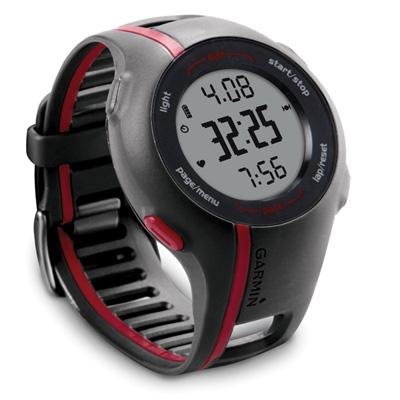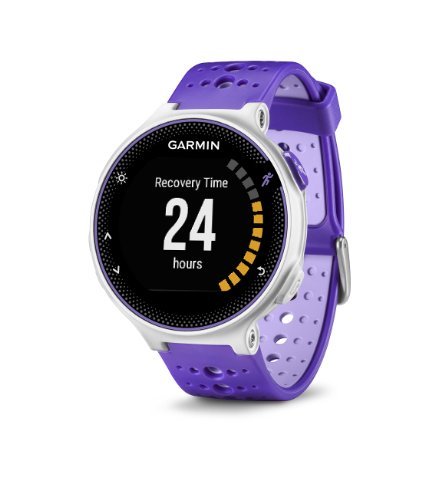
115258 Features: Keep track of how far you’ve run and how fast with this GPS-enabled watch; easy setup requires only a couple of questions for you and you’re out the door running HotFix satellite prediction system provides constant coordinates with a high-sensitivity GPS receiver that stays locked onto satellites, even near tall buildings and trees Record your laps and workouts to afterward you can download and track your data using the Garmin Connect website that provides analysis and sharing capabilities Record your laps with laps history feature that allows you to automatically start new laps with the Auto Lap feature Hear rate monitor not included Specifications: Weight to dimensions: 18 oz to 18 x 27 x 06 inches Display size: 10 x 10 inches Battery type to battery life: rechargeable lithium-ion to 3 weeks (power save mode); 8 hours (training mode) Waypoints to routes: 0
$ 199.00
|
1,085 of 1,108 people found the following review helpful
This 405 user loves his new 110, By
ldm616 (United States) – See all my reviews
This review is from: Garmin Forerunner 110 GPS-Enabled Unisex Sport Watch (Black) (Discontinued by Manufacturer) (Electronics)
BACKGROUND:
———– I have used a Garmin 405 to track my weekend long runs for about 1.5 years. Previously I owned the Garmin 305. I’m using the 110 with with my 405 chest strap (saved me ). SUMMARY: REASONS WHY I LIKE MY NEW 110 BETTER THAN MY OLD 405: * It’s smaller and less bulky than the 405, looks and feels like a regular watch, and wraps snugly around my smallish wrist. * I don’t have to fiddle around with the temperamental 405 touch-(in)sensitive bezel. * The displayed numbers for distance/hr/time/pace are bigger on the 110 than the 405, so easier for me to read on the run. * There are fewer menus to navigate. * Like the 405, GPS locking and accuracy works just fine, even under trees (more below). * Like the 405, I can set the auto-lap to increment every 1 mile (other distances available). * The 110 displays everything I want to track during and after my run. * To make this tangible, I can glance at the watch to see that so far I’ve run 2.1 miles in 21 minutes, my current HR is 160, my pace for the current mile (mile 3) is 9:56 and my pace for the last lap (mile 2) was 10:01. At the end of my run, I click through to “History” and see that my average HR for the entire run was 162bpm and my average pace was 9:54 minute miles. For me, currently, all I care about is keeping my HR in the 160-170bpm range (your range will probably be different) while trying to keep my pace under 10:00. In general, I suspect most runners will have the same requirements: Track your current HR to keep it within a target range while attempting to meet or beat a per-mile pace goal. * The 110 has a longer battery life * I never used the other 405 features like courses, virtual partner, etc. Ironically, I “customized” the 405 screens to pretty much do what the 110 displays by default (but cannot be changes). WHAT’S ALL THE FUSS ABOUT “CURRENT PACE”? I guess some runners want to know the pace they are running RIGHT NOW. Think of it as their instantaneous pace – kinda like what a car speedometer gives you. Some folks call it “current pace” but that can be confusing when you also have average pace for the current mile, so let’s call current pace the “right-now” pace. Unlike the 405, the 110 does not give you your right-now pace. Instead you get your average pace for the current lap. If your auto-lap is set to 1 mile (the default setting) then you’ll see your average pace for the current mile. I for one don’t need right-now pace. Since I’m trying to hit per-mile pace goals I want to see my average pace for the current mile. If I’m trying to hit a 10:00 pace for the current mile, and I start out too slow, the 110 will tell me my average pace for the current mile is slower, let’s say 11:00, and I know I need to run the rest of the mile faster to bring my average pace for the current mile down from 11:00 to my target pace of 10:00. As I speed up, my average pace for the current mile will slowly drop from 11:00 to 10:00. Bottom line: Right-now pace doesn’t help me hit per-mile pace goals so I could care less if it’s “missing” from the 110. If all you are doing is trying to hit per-mile pace goals (eg run a 10:00 miles) then you’ll be just fine with the 110. ANY GPS ISSUES? Not for me. Check out connect dot garmin dot com slash activity slash 44862992 and you’ll see my test walk/run. Click to view the map in “Satellite” mode and notice that most of my test walk was under thick tree cover. 0
426 of 445 people found the following review helpful
Does what it says it does well, By
Mike (CT) – See all my reviews
pros-quick satellite fix, very clear display, waterproof, shows the info you need not what you don’t, uses buttons instead of bezel controls, uses USB instead of wireless connection.
cons-fairly expensive, GPS loses some accuracy under heavy tree cover. This watch is especially good for two kinds of runners: those who run on trails, and can’t easily lock in distances (and thus pace); and those who travel, but still want to run outside, rather than on hotel treadmills. In both instances, this watch will give you accurate distance information, as well as pace and heart rate. The other big improvements that I haven’t seen mentioned in other reviews are that unlike the 405, it has reverted to button controls, and also to a direct USB cable connection to your computer for uploading run information. Garmin is not advertising these changes, since they are ostensibly steps backward from the 405’s bezel controls and wireless connection, but these were the sources of most of the complaints about the 405–especially problems with the bezel once it got wet with sweat or rain. This is no longer an issue. You have to wonder whether some of the people writing these (one star) reviews actually run–or whether they work for Polar or Timex? The watch gives you distance, time and pace, as well as heart rate information, as you go. For most easy or long runs on trails or the road, this is all you need. On the track, you know the distance, so if you’re doing intervals, just use the stopwatch. The only scenario where the lack of ‘current pace’ could be a problem as far as I can see is in doing tempo runs, if you do do them by time (say 20 minutes easy, 40 minutes tempo, 10 minutes warm down) instead of by distance, as I do them. By time, you could get a situation where your first and last miles of tempo running get mixed in with running at an easy pace, and the pace data would be useless. Still, if you set the autolap function at .25 miles, very little of your run is going to be logged inaccurately (at most the first and last quarter mile in that tempo workout). Similarly, if you happen to be changing pace lot during a run and want immediate feedback, the watch does give you that. So-called current speed on a GPS watch is always somewhat of an estimate anyway, since it is plotting your location between two points, measuring the time it took you, and then doing the math. There’s really no such thing as an instantaneous current pace calculation, and if you have your watch set on .25 mile autolap, that’s not much more than the distance that would actually be used for a current pace calculation otherwise. One criticism: although the satellites initially lock onto my watch after an average of 30 seconds and seem to give very accurate distance ad elevation information (the latter on the Garmin Connect website), there is one part of my usual run under heavy tree cover where it seems like the satellites lose me for a tenth of a mile or less, which makes the data for that mile always come out slower than I’m actually running. It makes up the difference on the next mile, which makes that one come out too fast. Both are off by around 15 seconds/mile, and this is a bit annoying. Although I can do the calculation to average the two and see that each time they basically come out even, it seems that Garmin should have come up with an algorithm for the watch’s software that would compensate for such discrepancies within the mile where they happen, rather than giving inaccurate information for two consecutive miles. Bottom line: this watch gives you a lot of useful information, and even more when you download it to the Garmin Connect site. Unlike other Garmin watches, it doesn’t give some extra cycling information and the heart rate monitor doesn’t work in the pool, so it’s really a watch for runners, not triathletes. But for semi-serious to very serious runners, it gives you everything you need, without the bells and whistles–and the headaches–of the 405. 0
371 of 411 people found the following review helpful
I ABSOLUTELY LOVE IT, By
Bambi “Bambi” (DC/LA) – See all my reviews
Verified Purchase(What’s this?)
I’am no marathon runner, just trying to get back to running like back in my cross country/track high school days. It’s sooooo easy to use. I bought the 305/405 and immediately returned it because it was entirely too hard to figure out how to use. With the 110 you charge it, create your profile (weight, age, sex) go outside and let it sink with the satellites…then press start. It’s that simple. If you get the one with the heart rate monitor, it gives you calories burned, and heart rate. I see people in here griping about something regarding the “pace”. I don’t know..it displays the pace you are going at, so i’m not too sure what that is all about. You sync it with the garmin website, and it give you greater “in depth” information about your run.
Just remember that this isn’t suppose to have all the bells and whistle the other running watches have. This is for just simple use; distance, pace, calories, heart rate, time. This will suffice most people, and definitely extremely user friendly. 0 |




